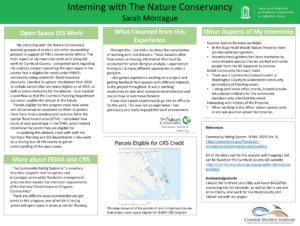
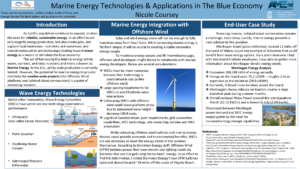
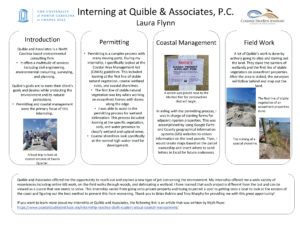
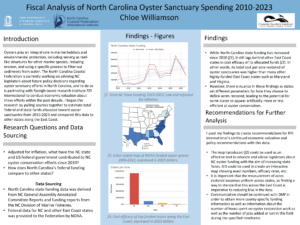
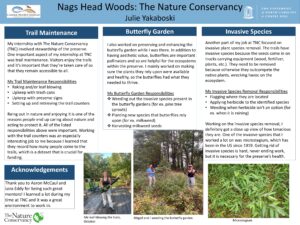
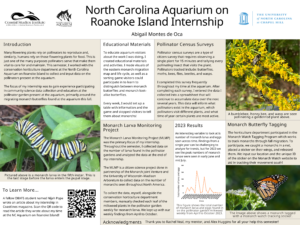
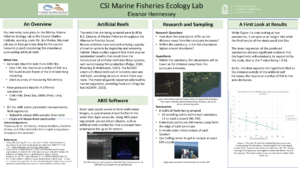
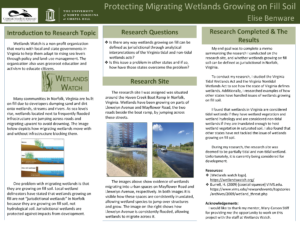
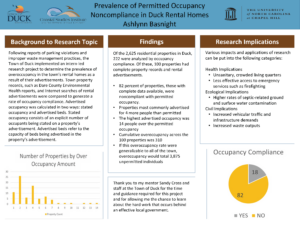
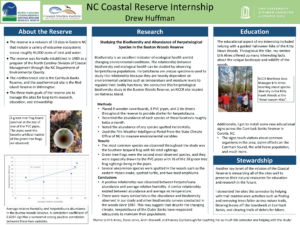
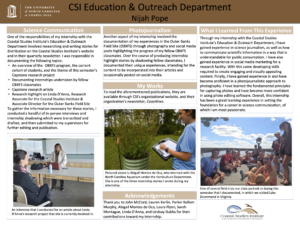
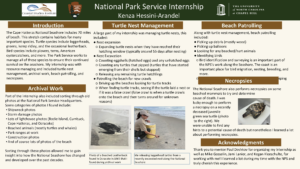












Hi! My name is Quinn Brewer, and I am majoring in Environmental Studies on the Sustainability Track. I am graduating at the end of this semester and am grateful to have spent my last few months as an undergrad with the North Carolina Coastal Federation. When I had my first conversation with Lindsay and Linda about what I wanted my internship experience to be like, I was all over the map. I hoped for an internship with a mix of office work and fieldwork with the main focus on advocacy. I wanted to immerse myself in the environmental community here in the Outer Banks, and with the help of my mentor, Alyson Flynn, I was able to do just that.
At the beginning of my internship, I had the opportunity to shadow Alyson as she led a meeting with representatives from various government agencies and nonprofits discussing the houses in Rodanthe that are on the verge of collapsing. This was the first I was hearing about these houses and the challenges with managing an issue like this. Rodanthe experiences high rates of erosion, which means its shoreline is shrinking quickly, while the houses remain unmoved. Unfortunately, these houses are sitting on the ocean just waiting to be swept away by it. So far in 2022, three houses have fallen into the ocean leaving miles of debris scattered up and down the beaches. The first meeting I attended was bringing together stakeholders to visit the other 12 properties that are sitting on the sand, assess the problem, and begin discussing future action plans that need to be taken immediately. As the semester went on, I attended a follow-up meeting with some of the same and a few new people as they are continuing with this pressing work. Through these experiences, I was able to understand the different roles stakeholders have and how they collaborate to generate solutions to critical environmental problems.
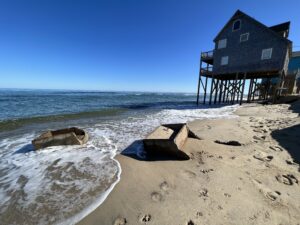
Through the Coastal Federation, I was also invited to attend other conferences and workshops to learn about problems arising from climate change. One of these events was the Climate Adaptation Workshop. This workshop brought together representatives from the National Park Service, Audubon Society, US Fish and Wildlife, and many other esteemed organizations to brainstorm actions to manage populations of certain endangered species that will be impacted by sea-level rise in the Outer Banks. I mostly spent days like these learning about the environmental challenges and how different agencies are addressing them.
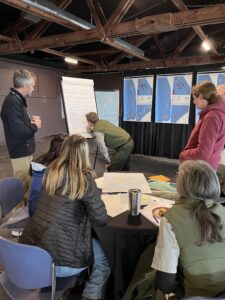
Some of my favorite days of my internship was conducting litter removal audits on the Coastal Federation’s adopted highway in Wanchese. I was able to collect data for Sarah Hallas, the Coastal Education Coordinator, about the amount and types of garbage found on the same portion of the road each month. The data I collected will be used to advocate for policies regarding waste on a local level.
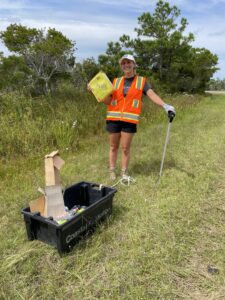
In between all of the meetings and conferences I attended, I completed a project about microplastics. In July 2021, the Coastal Fed hosted the North Carolina Coastal Microplastics Forum. This forum brought several speakers to discuss the latest research regarding microplastic pollution. They discussed their own research and areas where further research is needed to assess the risk of ingesting microplastics to humans and other species. This subject area is relatively new, so much is still unknown about it. My project for the Coastal Federation was to research new policies, technologies, and initiatives that have been completed since the forum and identify gaps in knowledge and research. The information I have collected will be used by the federation for future action that aligns with their goals of advocacy and education.
Overall, I loved my time interning with Alyson at the North Carolina Coastal Federation. The mix of advocacy work both in and out of the office and learning how organizations collaborate to find solutions for current environmental threats were incredibly valuable experiences for me as I move into the next chapter in my life. This internship inspired me to continue advocacy work for a nonprofit after I graduate. I am appreciative of all of the guidance and opportunities Alyson and the rest of the Coastal Federation staff gave to me this semester.
This semester, I (Julia Elliott) interned with the National Park Service at the Cape Hatteras National Seashore. Since UNC is giving us course credit for our internships, I tried to imagine what the syllabus would look like: go to the beach at sunrise, admire turtle hatchlings, make friends with Park Rangers, and learn a heck ton about the seashore. Quiz questions include, but are not limited to: how to tear open an undeveloped turtle egg without having it spray onto your face, how to walk up old lighthouse stairs with marshmallow feet, and how NOT to get a deceased dolphin stuck in the walk-in freezer. Welcome to the UNC course, ENEC 395: Bridges in the Outer Banks, taught by Professor Doshkov and Professor Gosselin.
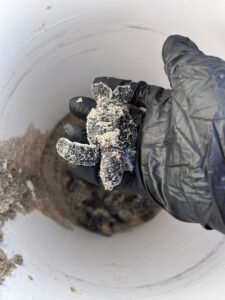

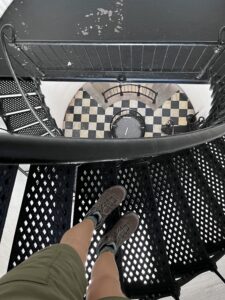
Bridges
To get to the Outer Banks, one must cross a series of bridges. They extend over rivers, sounds, and inlets. Like the bridges that connect shifting barrier islands, there are also bridges connecting both ecological processes within ecosystems, and people within society. I traversed these various bridges with Mike Gosselin and Paul Doshkov, and numerous others, nearly twice a week for the past three months.
Physical
We frequently passed over the Bonner and Jughandle bridges to access various on-ramps to the beach. As far as I could tell, Oregon Inlet lived up to its name as one of the most dangerous inlets on the East Coast. Passing over it twice a week allowed me to assess its ever-changing nature; some days it was calm, others I could’ve washed my clothes in the washing machine-like waters. Like the waters underneath the bridge, the traffic pattern was constantly changing as construction workers reworked different sections. Despite all these seemingly perpetual changes, Great Black-Backed Gulls and Lesser Black-Backed Gulls (both valued equally) always lined the railings, and the road, as we traveled South in National Park trucks, sea-sprayed and shaking from the grains of sand on the purposefully deflated tires. Physically traversing the bridges was not my only experience with them; I traversed through their history in the archives at Fort Raleigh. Working with Jami Lanier, I leafed through hundreds of documents about the construction of both bridges, from Environmental Impact Statements to correspondences concerned about various related issues. I saw pictures of the various stages of planning and building, giving me an extra appreciation for the amount of work it takes to build any structure, but especially miles-long bridges spanning tempestuous waters and connecting vulnerable islands (and strong enough to hold all those pesky gulls, of course).
Social
This increased appreciation for bridge architecture and city planning comes with an increased appreciation for social bridges, as well. As someone who grew up in various medium to large-sized cities, the more tight-knit community of the Outer Banks has never failed to impress me.
I’ll provide an example. I was sitting in the archives in Fort Raleigh, creeping up on hour four of organizing and identifying shipwreck photos. My initial excitement at the age of some of these documents was wearing off as my post-lunch dreariness began to kick in. I picked up a photo of a huge ship on the beach, wondering how the captain managed to strand a WW2 era battleship. I flipped over the dated photo to see who had taken it, and to my surprise, I recognized the name! Michael Halminski, a well-known name in the Outer Banks, had taken the photo in the ‘70s. He had come up many times in my conversations with my journalism-and-photography-inclined classmate, Emmy.
Similarly, on the second day of my internship, I drove an hour and a half south to the Cape Hatteras lighthouse. I went down there to meet Michael Flynn and Kegan Kleeschulte, who were surveying the inside of the lighthouse for a restoration project. I apprehensively hopped the fence keeping the public from entering the lighthouse, and met them for the first time. Michael expressed knowing Quinn – “What’s her name? Gwen?” – one of my fellow classmates. His wife, Alyson, was Quinn’s internship mentor. The connections thus continued. Perhaps this is a very common occurrence and a natural part of life for those who call small communities home. But for me, slowly building these bridges between seemingly unrelated people I met allowed me to feel like a part of the Outer Banks network.
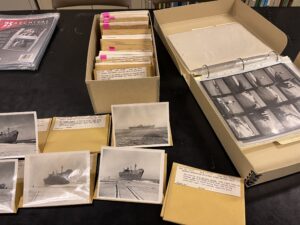
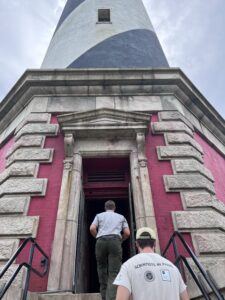
Ecologically Educational
I also built many bridges between the themes of my classes at the Coastal Studies Institute and the things I saw from the NPS truck window. In Coastal Ecology, for example, I learned about ghost crabs and their importance as an indicator species. The next morning on the beach, I saw the effects of ghost crab predation on sea turtle nests as the sun rose behind me. In Coastal Law and Policy, we learned about the North Carolina laws limiting erosion control measures on the beach, which was difficult to understand after continually driving by steep, eroded escarpments. I was able to ask the town commissioner of Nag’s Head about the exposed septic tanks in Rodanthe after spending a morning with Mike filling the bed of our truck with PVC pipes and heavy wedges of wood from brand new stairs that had collapsed. I spent another morning with Paul taking photos of pieces of tar paper, carpet, and insulation that was still washing up onshore, months after the houses had fallen into the ocean. They work hard to clean up the mess caused by insurance companies’ policies allowing homeowners to collect insurance only after the houses collapse into the ocean.
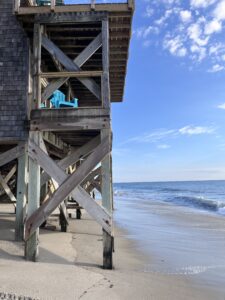
In my opinion, this is what college should be – having the opportunity to bridge the gap between valuable theoretical knowledge and hands-on, real-world experiences.
Another aspect of my internship was assisting in marine mammal strandings. A few of my classmates jokingly expressed concern at the level of enjoyment I derived from necropsies, or animal autopsies. It got to the point where Paul was saving stranded turtles in the fridge for me to help necropsy (thanks Paul!). My fascination was not innately morbid, and came only after a brief reflection on and appreciation for the life it had lived. After these considerations, I was engrossed in the process. Watching Paul and the stranding coordinator, Marina (who also happens to be Paul’s wife – another bridge!), expertly perform a necropsy on an adult Risso’s dolphin was an experience I will never forget. I can’t describe the inside of the dolphin as anything other than beautiful – the colors of the organs, the squiggly lines of the veins, the connection of the lungs to the blowhole… it was like an entire universe, complete with its own planets and constellations, lived inside of this dolphin. Every part of its body was connected by various bridges, just like every function the dolphin provided to its environment helped bridge an ecosystem together.
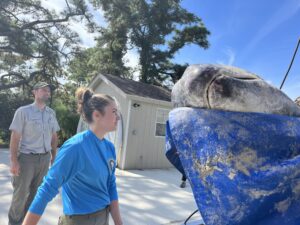
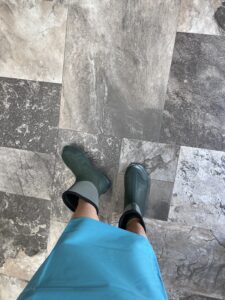
Willet, or won’t it? (…credit to Paul on that one)
I’d like to add a few more random tidbits (perhaps some pieces that fell off of my metaphorical bridge) that I feel encompass my time with the National Park Service:

I learned a lot of new birds. Willets, Sanderlings, Plovers, Cormorants, my two personal favorites, Terns and Ruddy Turnstones, to name a few. Paul told me about four-letter bird codes, which helps when documenting location and activity of certain birds. American Oystercatchers are AMOY, Piping Plovers are PIPL, Paul Doshkov is PADO, Julia Elliott is JUEL. My Toyota Yaris is TOYA. I gave all of my roommates their four-letter bird codes, too.
I could go on about the valuable things I saw and learned during my three months working on the Seashore. I got to see the way the beach changed on a day-to-day basis – how the impact of Hurricanes Ian and Nicole affected both the shape of the beach and the turtle nests. I worked first hand with sea turtle nests and turtle hatchlings (which I have written surprisingly little about, despite it being an important and rewarding part of the job). I learned how to get up ridiculously early (4:30am on some days), and what it was like to truly be valued and respected in a job position. I want to thank Kegan, Jami, Michael, and many other Park Service employees for their kindness and patience. Mike and Paul – you both have truly made my experience in the Outer Banks one to remember. And thanks to Lindsay and Linda for accepting my request to work with the Park Service – it’s been great! Time to keep building my bridge towards the next adventure.
Hello, my name is Sophie Nichols. This semester I had the opportunity to work alongside Aaron McCall at The Nature Conservancy’s Nags Head Woods Preserve. After telling Linda and Lindsay I wanted to work for a refuge / preserve, while also tackling on a semester-long GIS mapping project, I was placed at Nags Head Woods. Although I learned about conservation management in several of my classes, I wanted to gain hands-on experience working in these protected spaces. I wondered what management looked like day-to-day and how the non-profit machine operated to preserve these key habitats. Also, I have an interest in GIS, so I wanted to build my skills over this semester.
What is Nags Head Woods?
Nags Head Woods is a preserve owned by the Nature Conservancy. The towns Nags Head and Kill Devil Hills donated patches of land to the Nature Conservancy, but the non-profit also purchased tracts outright. Unlike most preserved lands, the public is able to traverse and hunt (bow hunting only) in these spaces. As a maritime forest, these woods grow atop relic dunes on ridges and in swales. Nags Head Woods is home to over 550 animals including river otters, muskrats, bobcats, warblers and many others.
At my internship, I balanced outdoor work (e.g. invasive removal & trail maintenance) and mapping tasks (designing & publishing print/web maps).
maintenance) and mapping tasks (designing & publishing print/web maps).
I also learned about coastal invasives––english ivy, pampas grass and nutria. Although weeding can be monotonous at times, it provides a time to destress, observe nature, and think holistically about conservation management.
 Being deep in the weeds forced me to slow down and watch my surroundings. I saw tiny frogs hug the coneflower stalks, bumble bees buzz around the native perennials and heard pileated woodpeckers drill away at the pines. Being around these animals helped me realize how interconnected all the
Being deep in the weeds forced me to slow down and watch my surroundings. I saw tiny frogs hug the coneflower stalks, bumble bees buzz around the native perennials and heard pileated woodpeckers drill away at the pines. Being around these animals helped me realize how interconnected all the
species are and how important it is to conserve forests in developing areas. Also, since ArcGis Pro can be especially finicky, being able to step outside and walk the trails to collect my thoughts and create a game plan was great.
Another aspect I enjoyed was talking to visitors. Anyone can ring a bell at the front office, and my coworkers and I will answer their questions. Taking a break and talking to visitors and locals about the woods, ponds, and trails, was a great experience. I also got lucky, because my internship was especially flexible. One day I tagged along with Aaron to Swans Quarter to record a living shoreline. I learned about the prevalent communication conflict between biologists and engineers, as well as what materials are key to rebuilding marshes. Another day, I walked every single trail at Nags Head Woods, clocking in about 17,000 steps or just over 9 miles.
As for my semester-long project, I worked on creating a Hunters’ Map and General Map for Nags Head Woods. Aaron worked with me to devise this project. To make these maps, I first researched the Nags Head Woods deer management program and learned about the local hunters bow-hunting in the forest. Then I designed a map, utilized historic data, and generated new data to create the map. The reason I walked 9 miles one day was to record polylines, tracks, of every single trail via a handheld Garmin device. I’d never recorded data like this, so I enjoyed the novelty of it.
Overall, I learned a lot from my work and coworkers. I gained knowledge about coastal easements and accompanying management and strengthened my mapping skills.
Lastly, I want to say thank you to my coworkers Eric, Lora and Aaron. It was never a dull moment in the office. I learned a lot by just asking questions and listening to you guys talk about things like carbon offsets, or interview candidates for the Elizabethan gardens. I learned a lot from our work days and the project you, Aaron, designed for me. Also, special thanks for fixing my flat tire on the first day of internship.
Hello everyone-
I’m Anna Smith. I’m a senior from Atlanta, GA majoring in Environmental Studies. This semester I had the opportunity to intern at Quible & Associates, a private environmental consulting and engineering firm. My mentor was Brian Rubino, the Vice President of Quible and a professionally licensed geologist.
Going into the internship with Quible, I had no idea what to expect, which from my perspective was kind of the point. All I knew was that I wanted a dynamic internship which would provide me with interdisciplinary opportunitiesto learn. Upon my first meeting with Brian, he too wanted me to have as expansive a learning experience as possible and proposed that instead of working on one main project, I would be involved in many different ones. As a result, my time was balanced between working at the office in Powell’s Point and out in the field across the Outer and Inner Banks.
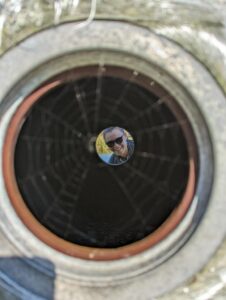
Yours truly
Quible & Associates, Private Consulting
Fieldwork:
Standing neck deep in turbid water on my first day, I distinctly remember thinking two things: 1) how in the world did I end up in this situation and 2) this is awesome. Beyond being told that I would be in waist-high (give or take) water, I did not know what I would be doing or where. As someone who tries to be organized, the lack of information initially made me nervous. But after my first day, I knew that I could trust Brian and that he would not put me in a poor position. Unlike most every other member of the cohort, I rarely knew far in advance what I’d be doing, where I would be going or with whom, or for how long. I share this element of my internship not as a complaint, but to reveal how this taught me to always be prepared for anything with Quible. I always kept a set of warm weather and cold weather field clothes in my car in addition to snacks, sunscreen, and anything else I might need.
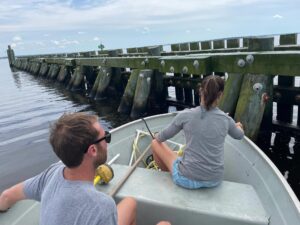 Checking out a breakwater in Belhaven NC with Brian + Troy
Checking out a breakwater in Belhaven NC with Brian + Troy
Additionally, this internship revealed the power of simply showing up and fully committing to the task at hand regardless of the situation. Whether it was surveying the eroding shoreline in Swanquarter or delineating wetlands in Corolla or taking annual well samples in Merry Hill, Brian allowed me to jump right into whatever fieldwork was being done. Each day in the field was an adventure where I not only got to observe the fieldwork, but also learn on the fly by doing.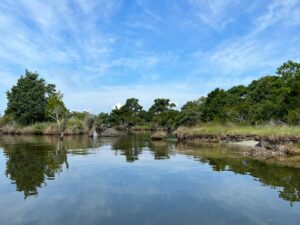
Surveying water depths at an eroding shoreline in Swanquarter, NC
Office work:
Similar to how I learned by doing in the field, I was also thrown into various office projects.To clarify, I was never sent off to work without any help. More or less, I was given some general information and resources by someone at Quible then told to give whatever task at hand a shot on my own. If I had any questions or confusion, everyone’s door was open for me to get their help. Once I felt like I had completed the work, I’d place the document in the Quible shared drive for the project manager to look over and provide feedback as needed. It was very collaborative which I appreciated, yet they also never coddled me and let me problem solve on my own which made me a better student and learner overall.
Well sampling data to be analyzed for annual DEQ report
Examples of office-related projects were filling out CAMA major/minor permits to send to the NC DEQ; stormwater drainage basin inspection permits; using county GIS data to notify adjacent landowners of CAMA projects; and using wetland delineation field notes to fill out data sheets related to the soil, hydrology, and vegetation of an area.
Elevation map for shoreline protection proposal by Quible
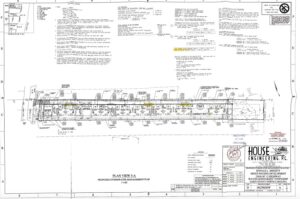
Engineering plans used to complete stormwater inspection report
All in all, I walk away from my time at Quible with lots of fun memories from adventures and extensive new knowledge learned. As I mentioned at the beginning, I never knew what to anticipate with my internship, but my primary goal of learning was achieved above and beyond anything I could have imagined.
Thank you to everyone at Quible for welcoming me into the firm and being willing to teach me within and beyond the scope of work. Thank you to Brian in particular for mentoring me this semester and being willing to indulge my curiosity. Lastly, thank you to Linda and Lindsay for helping arrange this opportunity along with the entire field site program.
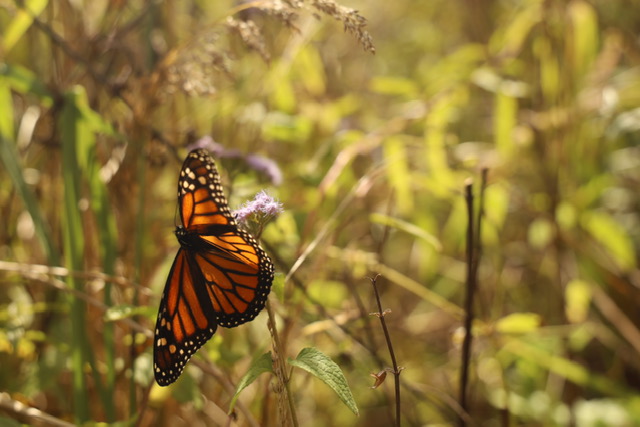
Bursting from a shell
Black, yellow, orange, and white
Beating wings take flight
Butterflies have been the center of countless stories about rebirth and transformation. Kindergarten was filled with pictures of these insects. Adults get them tattooed as symbols of hope, bliss, and love. Butterflies have captured the imaginations of countless generations, yet we have not been the kindest to these muses.
Hi, my name is Jared Henry. Like almost everyone here, I’m majoring in Environmental Studies. However, I also have Political Science under my belt. I possibly want to pursue a Master’s in Public Administration and go into public or environmental finance. This semester I interned at the NC Aquarium on Roanoke Island under the head horticulturalist Rachel Veal. I know, a big departure from my future plans. Going into this semester and over the summer, I talked with Lindsay and Linda about experiencing something new. I have worked in an office environment before, but I was also interested in fieldwork. My only conditions were that it had to work with plants in some way, and it avoided any animal larger than a squirrel. When they told be about the opportunity to work with Rachel in the pollinator garden, it sounded like a perfect fit.

It might seem weird going to an aquarium to work outside with plants and pollinators, but it’s a pretty ingenious idea. Aquariums are already centers of public learning. Plus, cultivating an outside space allows for visitors to gain more experiences and knowledge than they would’ve at a traditional aquarium. My role in this was to conduct citizen science surveys. These initiatives attempt to get large sets of data across vast areas by making survey methods simple and reliable enough for the everyday person to complete. The surveys I completed collected data on bumble bees, monarch eggs and larvae, butterflies, and pollinator flower preferences. Even though these surveys are for citizens, there were many learning curves. Huge parts of these surveys included plant identification, recognizing monarch growth stages, and species identification. Luckily, Rachel was a patient teacher.
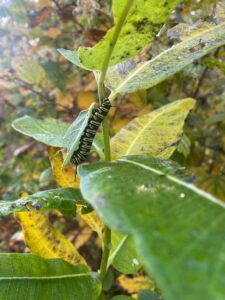
Day one I was overwhelmed. My clipboard was stacked with data sheets. All the plants blurred together, and the garden was filled to the brim with buzzing and movement. Now, those all seem like exaggerations. Well, except for all the insects. In fact, I was amazed about how much life was packed into one spot. My family has always had a vegetable garden and I was constantly outside landscaping with my mom, so I’ve seen my fair share of bees, butterflies, and wasps. But I had never seen or heard so many insects in a single area before. I’m not exaggerating when I say I could’ve cried.
Anyways, by the time my internship with Rachel ended, I was able to identify all the fall blooming plants, a lot of butterflies (not the grass skippers though), and the six native bumblebee species. I could tell you that pollinating flies are most attracted to white and yellow flowers because they can’t see red, most bee species don’t form hives, monarchs have five caterpillar growth stages, all the American Asters are now in the genus Symphyotrichum, and countless other facts. At the beginning of the semester, I couldn’t have told you any of this. Outside of the garden, I was able to help add plants to the pollinator habitat at the library in Kill Devil Hills, sell plants to and connect with community members at the Secotan Market, and participate in a beach cleanup.

I greatly admire Rachel and her work at the aquarium. It’s important that as more places become developed, local and migratory pollinators have spots to eat and live. Rachel is providing such a space, and she is encouraging community members to make their own pollinator habitats. It was sad leaving my internship, but I know I will carry on the lessons I have learned and share the knowledge I gained – just ask my mom.
Now, I’ll end this post the same way I began it:
Bursting from a shell
Black, yellow, orange, and white
Beating wings take flight
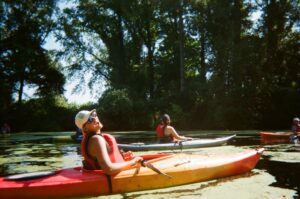
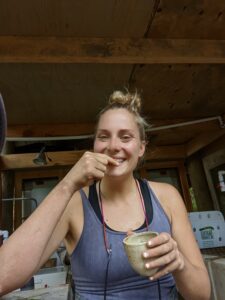 About Me
About MeHi! My name is Emmy Trivette, I’m a junior at UNC Chapel Hill. For the last two years of my degree I’ve been studying journalism, but because nature’s always called to me in more ways than one, I took on a second major in Environmental Studies in the spring. I grew up in Kitty Hawk, and after moving back for this field experience, I soon realized how many of my memories – swimming in the Albemarle Sound on Christmas or bodysurfing through many autumns in the ocean – were distinctly coasted by a childhood on the beach. When I jumped into the field site here at the Coastal Studies Institute, I felt entirely like a fish out of water, despite having grown up on the Outer Banks.
The classes were science, my peers seemed steeped in scientific experience, and even my internship revolved entirely around science. As intimidating as it was, it was exactly what I signed up for: complete, shocking immersion. While I could still hang tightly to that familiar thread of journalism, even then I found myself constantly being pushed to practice my photography skills by CSI’s Outreach Director, John McCord, and hone my digestibility of scientific papers.
My internship with the CSI Outreach Department was a deeper look as to how a communications department for a research lab functions. At the beginning of the semester my mentor John and I set several goals and deliverables for myself. Those included several articles, continuous photo documentation of the Outer Banks Field Site work, and a photo story. I’ve furthered my Lightroom editing skills, quickened my workflow, and most importantly, practiced my writing and photography skills almost waist-deep in a research environment. I did some of my best work and greatest mistakes as an Outreach Intern, but I’m sure there’s some great quote floating in the info-sphere about how that’s the way you learn – which is true.
After I leave the field site, and even after I drive a half hour back to Kitty Hawk to stay with my parents for winter break, I’ll head to Thailand for another semester abroad from Chapel Hill. Even after that I have only another year until I graduate, which is a terrifying thought. Despite that fear, which will probably hold fast beyond my graduation, this internship has allowed me to pursue my interest in photography further, and confirm that my comfort spot is in fact storytelling, and regardless of the challenges, I want to be in the game of environmental storytelling. In what form that will take as a career, I have no idea. With that said, I’m beyond excited to take these revelations with a still-open-mind as I head further into the working-world.
Hello, my name is Tara Hinton! I’m a sophomore here at the Outer Banks Field site, majoring in Environmental Studies (and possibly Folklore!) and minoring in G.I.S.
I came to the Outer Banks field site with interdisciplinary interests and experience in fieldwork but decided to focus on scientific research and hone my data analysis skills this semester. I had the pleasure of interning at CSI in the Ecology and Biochemistry in Marine and Coastal Systems Lab (Lindsay is the P.I.!) under Claire Johnson, a graduate student in the lab. Lindsay’s lab uses biogeochemistry to study productivity and nutrient cycling in aquatic, and marine ecosystems. As a graduate student, Claire is interested in nitrogen fixation by sargassum and phytoplankton in the Gulf Stream.
A bit about my role as an intern:
As an intern in this lab, my work was split between experiments and data analysis. Clair gave me responsibility over a couple of years of phytoplankton data, which I searched for trends. Throughout the semester, I worked on ways to visualize this large dataset in Excel; which involved many ridiculously-colored Excel spreadsheets. Here are a couple of figures that I created to visualize data. HABs, harmful algal bloom-forming species, are phytoplankton that can become a nuisance or are toxic to marine life. I looked into the abundance of HABs in three years of data that Lindsay and Claire collected from the Gulf Stream.
But it wasn’t all Excel spreadsheets and data analysis! With Claire’s guidance (and patience!), I developed an experiment to test nutrient use in phytoplankton from sargassum-dominated areas of the Gulf Stream. Essentially, I tested phytoplankton growth responses to the additions of nutrients, like phosphate and nitrogen, in different salinities. In relatively nutrient-poor areas of the Ocean, phytoplankton and sargassum play an important role in cycling nutrients, so it’s critical to understand how different communities respond to nutrients. Plus, with increasing anthropogenic nutrient inputs to aquatic environments, it’s important to understand how organisms at the bottom of the food chain react!
Gulf Stream Trip
Lindsay’s lab routinely makes boat trips to the Gulf Stream, collecting phytoplankton and sargassum for experiments as they go. I was delighted when Lindsay and Claire invited me to go out on the boat for a Gulf Stream Cruise in mid-October! I was so excited to collect phytoplankton samples for my experiment and venture out to the Gulf Stream for the first time.
Fieldwork almost always involves early mornings! Claire, Rebekah (our wonderful lab tech and OBXFS 21’er), and Emmy (our amazing photojournalist intern) left CSI far before the sun rose. After loading tens of empty buckets for water samples and sargassum onto a fishing boat, we set off of foggy Hatteras waters into the rougher swells of the ocean. And boy – seasickness is no joke! Fortunately, I felt better just in time to help out with data collection – and spot two sea turtles (sorry to disappoint – no pictures)!


After collecting data, water samples, and sargassum, we headed in and hauled our buckets and buckets into the truck and back to the lab. The sun set over CSI, and we took a break to chat and eat dinner together. These are some of the best moments in lab work; I love getting to personally know the brilliant people working alongside and mentoring me.
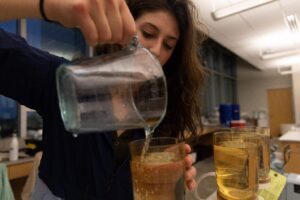
Analysis
After adding nutrients to my phytoplankton samples, Claire and I analyzed them for chlorophyll a content, and I analyzed my samples under the microscope. Although I’ve put all of my experiment supplies away, cleaned all of my beakers and vials, and closed up the microscope, I’m excited to continue analyzing the data that so many people helped me gather this semester.

Reflections
Thanks to the patience and knowledge of my mentor, I got a great taste of lab work in the ecology and biogeochemistry fields. There’s so much to say about what I learned, but a couple of lessons stick out.
Experimental design is an involved process, but staying on your toes in lab work is just as difficult! It is so important to have a printed experimental protocol during lab work, so that experiments go smoothly and efficiently.
Research is difficult, and it is alright to mess up. Between pipetting incorrectly and learning to perform dilution calculations on the fly to Gulf Stream-induced sea sickness, I have certainly had my fair share of not-so-graceful moments. It’s important to learn from mistakes but to also be gentle with yourself.
Research is as much about being playful and creative as it is about logic and expertise. This is a great attitude to have when trouble-shooting and designing experiments! Though I’m not sure if my future will hold more Gulf Stream cruises and phytoplankton experiments, I am so grateful for the experiences, expertise, time, and resources that my wonderful mentor, Claire, and my professor, Lindsay, have extended to me.
About Me
Hello, I’m Kayla Emerson! I’m a senior at the Outer Banks Field Site majoring in Environmental Science with minors in G.I.S. and Food Studies. This semester I spent my internship time on my senior honors thesis with Dr. Lindsay Dubbs as my advisor. Throughout my time at UNC I was able to be a part of a few really cool research projects and knew I wanted to dive more into independent research when I came to the field site. My research interests lie in the dynamics of wetlands and hydrological landscapes and their role in the storage and movement of carbon and nutrients. I find the movement of water and all that it holds through ecosystems fascinating, and important to combating climate change and understanding the effects of pollution.


My Project
My project dates back to March 2022 when I emailed Linsday asking if she would advise me through my senior honors thesis. Lindsay has a background in biogeochemistry and environmental gas fluxes (and is a stellar human being in general), so I was excited to get the chance to work with her. We spent the spring and summer planning a project for me to join and develop into something of my own, and forming my committee of mentors that would guide me through this process. Luckily, Lindsay found a way for me to hop onto a project that Dr. David Lagomasino and Dr. Sean Charles had just begun. David is an ECU professor and PI of the Coastal Oceans and Observing Lab and Sean is a post doc in the lab. David and Sean’s project focuses on sediment dynamics of the marshes in the Currituck Sound that have historically been used for waterfowl hunting.
To bring my own spin to the project, I am focusing on the groundwater and surface water of the marshes. I’m measuring basic parameters of the water such as dissolved oxygen, pH, and salinity. I am also processing water samples for dissolved organic carbon and nutrients, including nitrate and phosphate. What makes my project unique is that I am sampling marshes in the Currituck Sound and the marsh surrounding the Coastal Science Institute. These ecosystems have vastly different salinities and face different directions and are therefore influenced by different winds. My research aims to compare the carbon storage and nutrient profiles of water in marshes of differing salinities and wind influences.
Field Work
If you know me, you know that field work is my favorite part of research. This semester I got to do field work at two locations and even take a boat to my sites! When sampling in Currituck, we hauled CSI’s Carolina Skiff all the way up north and spent the day on the sound. David, Sean, and I gathered more people to help us out in the field and enjoyed their company. Upon anchoring at each marsh, I would hop out of the boat, find my way to the center of the marsh, and work with the groundwater well. After collecting my samples, I helped David and Sean collect sediment tiles and cores. As we made our way back to the boat, we tried our best to not fall in any holes and prevent Juncus puncture wounds. Field work is always a fun challenge and makes for great memories.


The second location I sampled at was the marsh surrounding CSI. Rebekah, 2021 OBXFS alum and now lab technician, and I take kayaks out on the sound to reach the new research boardwalk. We paddle out to the marsh edge, pull our kayaks onto shore, then hoist ourselves on the boardwalk. As we walk over the marsh, I hop on and off the boardwalk to collect water samples, CO2 samples, and measure water parameters.
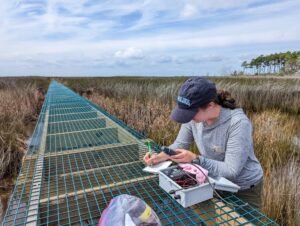

Takeaways
Although this semester was full of a lot of fun out in the field, it was also very challenging. Planning, conceiving, and conducting a research project is no small task. When I wasn’t out in the field, I was working independently on my literature review and organizing ideas into something I can conceptualize. However, being challenged academically is really important and I have an amazing team supporting me through this process. I’ve learned that research can be collaborative, even if you are alone, and there is always someone to answer your questions.
Unlike the rest of my peers, my project doesn’t end this semester. My Honors Thesis will continue next semester and culminate in a oral and written defense in April. As I wrap up my time here in the Outer Banks, I’m putting my field supplies away, and getting ready to spend more time at coffee shops on my laptop analyzing my data and writing my manuscript. I may have a lot on my plate and more in front of me, but I’m so excited for what the future holds.
Thank You
As my time at the Outer Banks comes to an end and the field season ends, I want to thank everyone who has been a part of my Honors Thesis this semester. Rebekah, thank you for joining me on field work days and sharing laughs with me as we stumble through marshes and try to not make a fool of ourselves. David and Sean, thank you for letting me join your project this semester. Thank you for answering all of my questions when we are out in the field and providing a different lens for me to understand the complex wetlands we are studying. Kriddie, thank you for being my role model in science. You taught me that science doesn’t have to be serious and to enjoy every moment of the process. I wouldn’t be doing this project if it wasn’t for your encouragement and teaching. From coding to climbing mountains, you always inspire me to go the extra mile.
Lindsay, thank you most of all for taking a chance on me and choosing to advise me through my project. Thank you for making connections for me and allowing me to lean on familiar faces. Thank you for guiding me on the right path when it comes to developing research questions and creating a project of my own. Thank you for your patience with me as I challenge myself and learn new aspects of the research process. I am so grateful that I get to continue to work with you and my other mentors next semester and make you proud with my final product come April.
My name is Josh Hyman, and I am a Junior studying Environmental Science. When it comes to my future, I have rather broad interests. I have known for years that I want my career to address Climate Change, but the more I learn the more I realize that this has not narrowed my options. Climate Change impacts and is impacted by almost all human action, meaning I still have to choose what part I want to play. Coming into the OBX Field Site program I expressed these broad interests, but with one qualification: I wanted to be at the nexus of research and implementation. To me there is an imbalance between the scientific research and implementation concerning climate change. I am rather uninformed about the diverse processes required to implement research and so there may be legitimate reasons for an imbalance or not one at all. With this information and described interest, I was paired with George Bonner, the director of the North Carolina Renewable Ocean Energy Program. Aligning with my broad description, my internship began with a broad request: understand the relationship between the blue economy and ocean energy in North Carolina so that opportunities may be identified. The geographic, environmental, social, and economic understanding required to accomplish this broad goal is expansive. Without direction I was lost reading papers, executive summaries, bills, and GIS tutorials. These resources taught me a lot about the coast of North Carolina, the people and businesses that exist here, and the policy that impacts renewable coastal energy. But no matter how much I learned, I didn’t seem to have a story to tell. All this information felt valuable for me and the end goal, but I could not find a narrative to bring it all together. All of a sudden, I had the research and time to find more information if needed, but I could not translate it into recommended action. I found myself where I wanted to be, but unable to take the step from knowledge to action. While I learned a lot of this internship, the largest lesson was about scope and relying on others. I had stayed too broad and relied upon my perspective and experience. When looking for my narrative, I realized that I had stayed too general and tried to do it all myself. I had thought I could truly understand the situation enough to identify what sectors had opportunities and what those opportunities are. If that process could be accomplishable by an individual with no experience in a few months, it would have been done years ago. The way that change is discussed in retrospect is on a large timescale of accomplishments and barriers. The successes and failures can be understood with so much context that it seems like a better result was so clearly within reach. In reality, the human systems I had been blaming for being behind the research where constantly working towards change in the ways and realms possible. My internship provided me with a necessary infusion of reality that is rare in education.